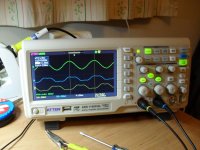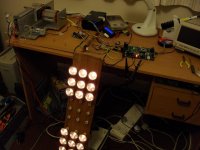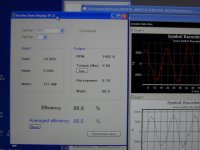Alan B said:Nice results! How exactly are the halls being used in the FOC algorithm?
They suppy the rotor angle data to the Park and inverse Park transforms.
Alan B said:Nice results! How exactly are the halls being used in the FOC algorithm?
Burtie said:Alan B said:Nice results! How exactly are the halls being used in the FOC algorithm?
They suppy the rotor angle data to the Park and inverse Park transforms.
Alan B said:If these Hall sensors are digital they provide 60 degree windows of angle information which is insufficient accuracy for FOC. Are they interpolating or doing something more clever with the Halls?
Alan B said:With FOC having a separate current term for flux / field weakening, why introduce timing advance errors into the algorithm?
mauimart said:I forgot to mention but also noticed that when I put a small load on the motor the speed reduces and input current remains the relatively constant. When I load the motor while driven with the other algorithms the input current will increase to keep the speed constant.
mauimart said:... I would like to outfit this motor with internal halls (120 degrees) and am unsure as to where (between which stator teeth) to place them. I recall it was different for delta vs. wye windings...




Burtie said:New cheap chinese oscilloscope
Get one --you will love it.
ctirad said:Nice. I like the wide LCD.
How is the quality compared to other similary priced chinese scopes like Rigol or Uni-t?
Teh Stork wrote
...before going apeshit over FOC; this is on a BLAC engine. A BLDC engine (trapezoidal bemf) with a six-step commutation can be just as efficient and well behaved as a BLAC sine controlled engine.
It's really dissappoiting to lay down countless hours down into optimizing FOC for use on a BLAC motor, then to have the same or better experience with a cheaper BLDC motor. I hate my HS3540 and 12fet for working as nicely as it does. Only optimalization is field weakening, thats as easy to implement on a blac as a bldc motor.
Burtie said:ctirad said:Nice. I like the wide LCD.
How is the quality compared to other similary priced chinese scopes like Rigol or Uni-t?
Can't speak for the Rigol or Uni-t, but the build quality of this Atten seems first-rate.
-dg said:Where did you get it? Which model is it? Thanks!
Burtie said:Following my disappointment at finding this FOC algorithm to produce no better efficiency (yet) than the simple six step algorithm, I found this quote from Teh Stork on page 11 of Arlo's power stage thread:
Teh Stork wrote
...before going apeshit over FOC; this is on a BLAC engine. A BLDC engine (trapezoidal bemf) with a six-step commutation can be just as efficient and well behaved as a BLAC sine controlled engine.
It's really dissappoiting to lay down countless hours down into optimizing FOC for use on a BLAC motor, then to have the same or better experience with a cheaper BLDC motor. I hate my HS3540 and 12fet for working as nicely as it does. Only optimalization is field weakening, thats as easy to implement on a blac as a bldc motor.
Sounds like you have already been down this road Stork ?
Teh Stork said:What you've quoted me on is true, but there is some factors that makes FOC desirable:
1. FOC is more robust, in case of a sensor failure.
2. FOC decreases current ripple seen by capacitors*
3. FOC is silent compared to six-step.
4. Field weakening can substantially increase speed of motor, and you need FOC to realize this.
...Oh, and one thing - you're using a purely resistive load, this is far from a real setup witch has to deal with inductance forcing currents to flow.

Lebowski said:To be honest, I like FOC ...Once you have it, there are some good things it gives you. It gives you automatic timing
compensation. This is especially important for high erpm motors above the L/R frequency.
Also, it's very easy to implement very smooth torque control and braking (regen) control.
Burtie said:They are both wound Delta. Any inefficiency in the generator does not affect the result.
The output is calculated from speed and torque measurements. Torque is measured directly from the motor frame
